
Euphorbia mellifera, the Canary spurge or honey spurge, is a species of flowering plant in the spurge family Euphorbiaceae, native to Madeira and the Canary Islands. It is an evergreen shrub growing to 2 m or more, with narrow leaves up to 20 cm (8 in) long. In spring it produces brown, honey-scented flowers.

Lavandula stoechas, the Spanish lavender or topped lavender (U.S.) or French lavender (U.K.), is a species of flowering plant in the family Lamiaceae, occurring natively in several Mediterranean countries, including France, Spain, Portugal, Italy and Greece.

Grevillea robusta, commonly known as the southern silky oak, silk oak or silky oak, silver oak or Australian silver oak, is a flowering plant in the family Proteaceae. It is a tree, the largest species in its genus but is not closely related to the true oaks, Quercus. It is a native of eastern coastal Australia, growing in riverine, subtropical and dry rainforest environments.
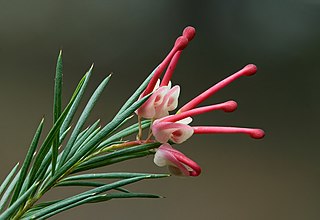
Grevillea rosmarinifolia, the rosemary grevillea, is a plant of the family Proteaceae.

Lavandula angustifolia, formerly L. officinalis, is a flowering plant in the family Lamiaceae, native to the Mediterranean. Its common names include lavender, true lavender or English lavender ; also garden lavender, common lavender, and narrow-leaved lavender.

Escallonia is a genus of shrubs and trees in the family Escalloniaceae. They are native to North and South America.
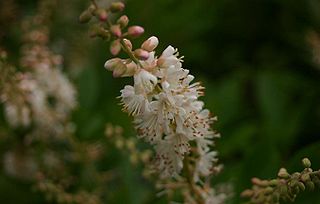
Clethra alnifolia, the coastal sweetpepperbush or summersweet, is a species of flowering plant in the genus Clethra of the family Clethraceae, native to eastern North America from southern Nova Scotia and Maine south to northern Florida, and west to eastern Texas.

Ligustrum lucidum, the broad-leaf privet, Chinese privetglossy privet, tree privet or wax-leaf privet, is a species of flowering plant in the olive family Oleaceae, native to the southern half of China and naturalized in many places: Spain, Italy, Algeria, Canary Islands, New Zealand, Lesotho, South Africa, Japan, Korea, Australia, Norfolk Island, Chiapas, Central America, Argentina, and the southern United States. The name "Chinese privet" is also used for Ligustrum sinense.
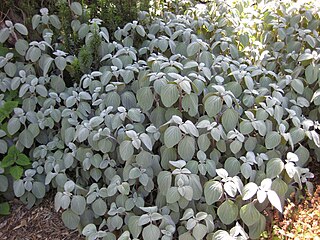
Coleus argentatus, synonym Plectranthus argentatus, common name silver spurflower, is a species of flowering plant in the mint family. It is native to rock outcrops and rainforest in the border region of Queensland and New South Wales, Australia. Growing to 1 m (3 ft) tall and broad, it is a spreading deciduous shrub. The hairy leaves are ovate to broad-ovate, 5–11.5 cm long, 3–5.5 cm wide with crenate margins. The hairs give the plant an overall sage green to silvery colour. The flowers are borne on terminal racemes up to 30 cm (12 in) long, and are bluish white.

Hibbertia scandens, the snake vine, climbing guinea flower, golden guinea vine or gold guinea plant, is a species of flowering plant in the family Dilleniaceae, native to Australia but widely cultivated. Growing to 4 m (13 ft) in length, it is a climbing or sprawling evergreen shrub with glossy leaves and solitary, bright yellow flowers.

Phlomis fruticosa, the Jerusalem sage, is a species of flowering plant in the sage family Lamiaceae, native to Albania, Cyprus, Greece, Italy, Turkey, and countries of the former Yugoslavia.

Melianthus major, the giant honey flower or kruidjie-roer-my-nie, is a species of flowering plant in the family Francoaceae. It is an evergreen suckering shrub, endemic to South Africa and naturalised in India, Australia and New Zealand. It grows to 2–3 m (7–10 ft) tall by 1–3 m (3–10 ft) wide, with pinnate blue-green leaves 30–50 cm (12–20 in) long, which have a distinctive musky odour. Dark red, nectar-laden flower spikes, 30–80 cm (12–31 in) in length, appear in spring, followed by green pods. All parts of the plants are poisonous.

Acacia pravissima, commonly known as Ovens wattle, Oven wattle, wedge-leaved wattle and Tumut wattle, is a species of flowering plant in the legume family Fabaceae. It is an evergreen shrub native to Victoria, the South West Slopes and Southern Tablelands of New South Wales, Australia.

Salix acutifolia, also known as Siberian violet-willow, long-leaved violet willow or sharp-leaf willow, is a species of flowering plant in the family Salicaceae, native to Russia and eastern Asia. It is a spreading, deciduous shrub or tree, growing to 10 m (33 ft) tall by 12 m (39 ft) wide. The young shoots are deep purple with a white bloom. The leaves are narrow, up to 10 cm (4 in) long. The catkins are produced in early spring, before the leaves. Older bark has a fine, netted pattern.

Prostanthera cuneata, commonly known as alpine mint bush, is a species of flowering plant in the mint family Lamiaceae, and is endemic to mountainous areas of south-eastern continental Australia. It is an erect, compact shrub with egg-shaped leaves with the narrower end towards the base, and pale lavendar to almost white flowers with purple blotches.
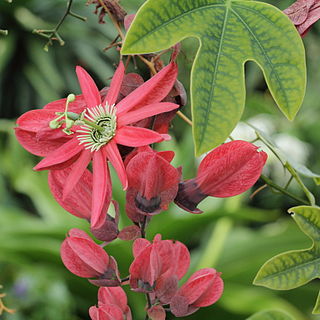
Passiflora racemosa, the red passion flower, is a species of flowering plant in the family Passifloraceae, native to Brazil. It is an evergreen climber growing to 5 m (16 ft), with simple or 3-lobed leaves to 10 cm (4 in) long, and vivid red flowers borne in summer. The flowers are 12 cm (5 in) in diameter, with purple and white coronas. They are followed by oblong green fruits.

Jasminum humile, the Italian jasmine or yellow jasmine, is a species of flowering plant in the family Oleaceae, native to Afghanistan, Tajikistan, Pakistan, Nepal, Burma (Myanmar), the Himalayas and south west China. The species is widely cultivated and reportedly naturalized in Greece, Sicily and the former Yugoslavia.

Eucomis pallidiflora, the giant pineapple lily, is a bulbous species of flowering plant in the family Asparagaceae, subfamily Scilloideae, native to southern Africa. The white to green flowers appear in summer and are arranged in a spike (raceme), topped by a "head" of green leaflike bracts. Some forms reach almost 2 m when in flower. The species is cultivated as an ornamental plant, although it is not hardy in areas where severe frosts occur.
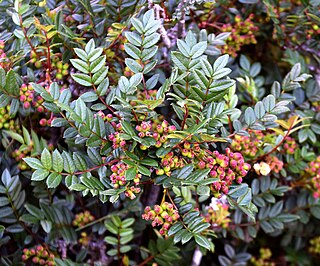
Sorbus reducta (铺地花楸), the dwarf Chinese mountain ash, is a species of flowering plant in the family Rosaceae, native to western China (South West Sichuan and North West Yunnan}. Growing to 1.5 m tall by 2 m wide, it is a dense deciduous spreading shrub. Each leaf, 10 cm long, has up to 15 leaflets which turn to brilliant shades of red in the autumn. White flowers in spring are followed by red or pink, and then white berries in autumn.

Gynura aurantiaca, called purple passion or velvet plant, is a species of flowering plant in the daisy family Asteraceae. It is native to Southeast Asia but grown in many other places as a house plant. In warm regions, it is frequently grown outdoors on patios and in gardens rather than inside buildings, and hence it has escaped into the wild in Africa, Australia, South America, Mesoamerica, Florida, and a few other places.




















